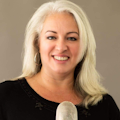ADHD, poor sleep quality, and dental hygienists: The missing link
We know that sleep is a medical issue. Oral health is a dental issue. Both are integral parts of a child’s overall wellness.1 But did you know that, in many cases, signs and symptoms of sleep concerns could be present in your dental chair? Sleep is an essential ingredient in a child’s life, and while it is not independent of oral health care, the professionals who treat sleep issues typically are. Many bodily processes occur during a child’s resting state, and scientists believe that sleep is no less important than food and exercise.2 When those sweet, gentle eyes close and soothing breaths rise and fall in the darkness of their rooms, children are given the perfect chance to recharge and restore. However, restless sleep is becoming alarmingly more common, and you, the dental professional, may be the first to notice! In fact, behavioral issues, facial changes, or a decrease in oral health can all be linked to a lack of proper sleep. Additionally, concerns about the child’s airway may be detected by a dental hygienist much earlier than by a parent, nurse, or other medical professional, for that matter.
For instance, the medical history review, hygienists may notice a recent round of antibiotics due to an ear or sinus infection, while also documenting large tonsillar tissue during the intraoral exam. These are signs that a multidisciplinary approach needs to be taken to prevent further issues for that child, as ear infections and large tonsillar tissues are classic signs of a compromised airway and poor tongue function.3 Dental professionals can even pick up on signs of sleep concerns and mouth breathing during innocuous conversations with parents about the child’s sleep habits. Parents may offer information about the child’s snoring and even issues with bed-wetting that are suggestive signs of mouth breathing and sleep concerns.
The dental professional is concerned about mouth breathing due to the increase in xerostomia, which in turn leads to an increase in childhood caries, gingivitis, and halitosis,1,4 whereas a nurse may be concerned about mouth breathing for a different reason. Nurses are not seeing concerns in the oral cavity like a dental hygienist would and may miss important signs. Hygienists! Patients are counting on you to speak up and say what you see.
Nighttime oral hygiene habits
There may be signs of poor brushing and interdental care that are observed during dental exams. When asked, the parent may mention that the child is tired, has fallen asleep on the couch, or is just cranky when trying to perform these nighttime tasks, leaving them to be shuffled through quickly or forgotten about altogether. Parents often point to attention deficit hyperactivity disorder (ADHD) or the child having a rough day as the culprit, but this deserves a bigger discussion. Suggesting an electric toothbrush or disclosing tablets to help the child focus on brushing technique are both great options for opening up this discussion.
Fatigue and adrenaline
The typical American day is overcrowded with places to be, events to attend, karate classes to drop a child off at. Even if children are not actively engaged in the activities surrounding them, they are likely to want to follow what is happening. When this occurs while they are already slightly sleep-deprived, their bodies experience a resource shift, and adrenaline surges to stave off the tiredness. The contradictory sensations allow children to be both wide-awake and drained at the same time.5 In this state, children become irritable, impatient, and demanding. This could happen while they sit in a dental chair or at night when their parents are trying to help them complete their nighttime oral care routine. If a parent explains what a battle the nighttime routine is, the dental professional sees this as a red flag and a warning sign that the child is potentially sleep-deprived.
Behavioral issues
Sleep and behavior are human functions that seem to have an undeniable connection. It is no secret that the amount and quality of sleep we achieve can drastically affect our daily behavior. We have all experienced increased irritability, anxiousness, and stress due to lack of sleep. It is no different for children, as poor sleep quality can lead to agitation, disruptive behavior, and the inability to focus. Interestingly, these are all symptoms we associate with ADHD. Coincidence?
ADHD
Adults and children behave differently when dealing with insufficient amounts of sleep: while adults become sluggish and lethargic, children become hyperactive, energetic, emotional, and show low impulse control. The similarities between ADHD and sleep deficit are so great that many scientists are rethinking our evaluation of ADHD diagnoses and questioning whether many of these children—and adults—may be suffering from sleep disorders instead.
The National Sleep Foundation’s article “ADHD and sleep” suggests that sleep deprivation can profoundly affect the symptoms of ADHD.6 Furthermore, the condition of ADHD can be triggered and intensified by several external factors, including situational and environmental stimuli, and sleep deficit. The link between sleep disturbance and ADHD seems to be so prolific that some scientists suggest responding to sleep issues in children could be enough to eliminate some of their issues with hyperactivity and attention deficit. The report further indicates that approximately 50% of children with ADHD developed sleep-disordered breathing, while only 22% of children without the disorder experienced these problems.
Although it is more commonly associated with children, adults can also suffer from ADHD and face myriad issues when it comes to mental and physical restlessness. Suffering from ADHD as an adult can have detrimental personal and professional effects. High levels of insomnia and other sleep-related disorders, such as sleep apnea, can also result in persecutory thinking or paranoia.7 Similarly, a lack of sleep can also result in impaired judgment, increased stress hormones, anxiety, and depression. These traits, mainly when considered in conjunction with ADHD, can result in serious harm to the individual and affect one’s ability to function in the world. Besides the obvious behavioral concerns, ADHD among adults is also linked to high rates of drug and alcohol abuse, as well as poor performance in educational and work environments.8
Snoring and poor sleep quality
In 2012, Karen Bonuck, a professor of family and social medicine at the Albert Einstein College of Medicine in New York, studied sleep disorders in 11,000 children. The study, published in the Journal of Pediatrics, found that children who snore or who display irregular sleep disorders such as apnea were anywhere from 40% to 100% more likely than those without to exhibit behavioral patterns similar to those with ADHD by age seven.9
No child should snore! Snoring may be indicative of airway issues. Airway issues may present very early on in the dental office as class II and class III malocclusions, crossbites, open bites from tongue thrusts, pacifier use, vaulted palates, crowded teeth, and large tonsils.1 Observations of a scalloped tongue and linea albea can be signs of parasomnias (abnormal or unusual behavior of the nervous system during sleep), such as bruxing.
Quality versus quantity
It is evident that, in order to have an optimal life experience that aids children’s healthy growth and development, they need a sufficient amount of sleeping hours. There is a common statement, “Quality over quantity.” However, sleep is a scenario where both are equally important. Uninterrupted sleep plays a pivotal role in the development of children’s nervous systems—they must get enough quality rest.10 In other words, don’t skimp on nap time!
Chronic sleep deprivation
The accumulation of missed naps and postponed bedtimes shows up, over time, as chronic sleep deprivation, and children’s fatigue during the day becomes problematic. In addition, the exhausted family’s diet becomes filled with more processed or fast foods. The child may even crave sugar or carbohydrates to help fight sleep deprivation, and all of this can increase the risk for dental caries.11 The best news is that these patterns can be changed!
Circadian rhythm
When adults travel across time zones, they experience an interruption in their circadian rhythm. For children, this natural sleep cycle gets stronger as they develop. At first, it is irregular, although, with proper attention to their naps and ensuring they have good quality rest at night, their inner cycle regulates in a healthy way. When out of sync, children experience difficulty waking up or falling and staying asleep. They are more inclined to be irritable and distressed.
Sleep hygiene: Electronics
Dr. Vatsal Thakkar, a psychiatrist specializing in the treatment of ADHD patients and clinical assistant professor of psychiatry at New York University Langone Medical Center, points out that the rise of ADHD diagnosis in children in the 1990s and 2000s coincided with the proliferation of electronic devices into our homes.12 Let’s face it, our children are enamored with technology, with even the youngest members of the family reaching for the iPhone or iPad for hours of entertainment daily. Further, many teens say they text before going to bed—so much so, in fact, that many reported texting in their sleep. Many times, dental professionals can’t even get teenage and adult patients to stop using their phones during a dental exam, proving how pernicious electronic devices can be in all aspects of life.
Studies indicate that the light emitted from electronic devices prevents the release of melatonin, a necessary hormone that helps us sleep.12 Using electronic devices before going to bed can disrupt sleep cycles and prevent us from reaching the deepest, most restorative states of sleep. Combine that with a culture of overstimulation, and it is just harder for young people to unwind and settle into a healthy sleep pattern. If they have ADHD, this difficulty is exacerbated.
Treatment options
With the correct therapy and remedies, sleep hygiene problems in both adults and children can be improved and even fully corrected. While not such a common practice in adults, the option of removing tonsils and adenoids to alleviate breathing issues13 is available to improve sleep quality for children. However, the results are limited if structural issues are not also addressed. Oral appliance devices, palatal expanders, continuous positive airway therapy (CPAP), positional therapy, and myofunctional therapy are several options for improving airway conditions and increasing overall sleep quality. In addition, eating a nutritious, plant-based diet, improving nasal breathing, and engaging in regular physical activity can also improve sleep cycles and, by extension, relieve some symptoms of ADHD.14,15
Hope on the horizon
Although it may come as a relief to many that sleep deficit may be an underlying source to ADHD-like symptoms, more studies of the links between these two debilitating and life-threatening issues are needed. In the meantime, it is important to be mindful of the importance of healthy sleep for anyone, regardless of age.
Say what you see
Starting a conversation about ADHD or sleep habits may seem out of your scope of practice or expertise, but every dental professional can ask very simple questions and document the responses. Use the intraoral camera and radiographs to identify larger tonsils, crowded teeth, malocclusions, scalloped tongues, etc. This documentation can be sent to any health-care professional. Be sure to inform the parents that if they choose to discuss your findings with their pediatrician, the dental practice would be more than happy to help by sending supporting documents of any oral findings.
Dental professionals are aware of anatomical anomalies and have been identifying these for years. Now, looking at these anomalies through a different lens could help your youngest of patients and their struggling parents. In fact, it may be time to check in with your local pediatrician and really work toward having a collaborative team approach for successful, total patient care!
References
1. Ballikaya E, Guciz Dogan B, Onay O, Uzamis Tekcicek M. Oral health status of children with mouth breathing due to adenotonsillar hypertrophy. Int J Pediatr Otorhinolaryngol. 2018;113:11-15. doi:10.1016/j.ijporl.2018.07.018.
2. Harris KM, King RB, Gordon-Larsen P. Healthy habits among adolescents: Sleep, exercise, diet, and body image. Paper presented at: The Indicators of Positive Development Conference; March 12–13, 2003; Washington, D.C. https://www.childtrends.org/wp-content/uploads/2013/05/Child_Trends-2003_03_12_PD_PDConfHKGL.pdf. Accessed November 4, 2019.
3. Life of a tongue tie. Kidstown Dental website. https://kidstowndentist.com/life-tongue-tie/. Published November 13, 2018.
4. Faria PT, de Oliveira Ruellas AC, Matsumoto MA, Anselmo-Lima WT, Pereira FC. Dentofacial morphology of mouth breathing children. Braz Dent J. 2002;13(2):129-132.
5. Jacobson M. 10 dangers that overtired kids face. MetroKids website. http://www.metrokids.com/MetroKids/March-2013/10-dangers-that-overtired-kids-face/. Accessed November 4, 2019.
6. ADHD and sleep. National Sleep Foundation website. https://www.sleepfoundation.org/articles/adhd-and-sleep. Accessed November 4, 2019.
7. Freeman D, Pugh K, Vorontsova N, Southgate L. Insomnia and paranoia. Schizophr Res. 2009;108(1-3):280-284. doi:10.1016/j.schres.2008.12.001.
8. Molina BS, Pelham WE Jr. Attention-deficit/hyperactivity disorder and risk of substance use disorder: developmental considerations, potential pathways, and opportunities for research. Annu Rev Clin Psychol. 2014;10:607-639. doi:10.1146/annurev-clinpsy-032813-153722.
9. Bonuck K, Freeman K, Chervin RD, Xu L. Sleep-disordered breathing in a population-based cohort: behavioral outcomes at 4 and 7 years. Pediatrics. 2012;129(4):e857–e865. doi:10.1542/peds.2011-1402.
10. The truth about sleep and brain development in children revealed. Superior North Catholic District School Board website. http://www.sncdsb.on.ca/blog/sleep-brain-development-children. Published February 1, 2017. Accessed November 4, 2019.
11. Greer SM, Goldstein AN, Walker MP. The impact of sleep deprivation on food desire in the human brain. Nat Commun. 2013;4:2259. doi:10.1038/ncomms3259.
12. Breus MJ. ADHD or sleep disorder: Are we getting it wrong? Psychology Today website. https://www.psychologytoday.com/ca/blog/sleep-newzzz/201305/adhd-or-sleep-disorder-are-we-getting-it-wrong. Published May 1, 2013. Accessed November 4, 2019.
13. ADHD: Treatment. National Sleep Foundation website. https://www.sleepfoundation.org/articles/adhd-treatment. Accessed November 4, 2019.
14. Sano M, Sano S, Oka N, Yoshino K, Kato T. Increased oxygen load in the prefrontal cortex from mouth breathing: a vector-based near-infrared spectroscopy study. Neuroreport. 2013;24(17):935-940. doi:10.1097/WNR.0000000000000008
15. Holton KF, Nigg JT. The association of lifestyle factors and ADHD in children [published online ahead of print, 2016 Apr 28]. J Atten Disord. 2016;1087054716646452. doi:10.1177/1087054716646452.
About the Author
Michelle Strange, RDH
Michelle Strange, RDH, is a dedicated dental hygienist and educator passionate about infection control and patient safety. With over 20 years of experience in clinical practice, Michelle is committed to sharing evidence-based solutions to improve dental care outcomes.

Julia Worrall, RN, CCRN
Julia Worrall, RN, CCRN, also known as the Sleep RN, is a highly sought-after expert in sleep and airway health, connecting what was once thought to be disconnected. She is asked to speak at conferences and high-level meetings and featured on podcasts around the world. As a passionate airway advocate and mentor, Ms. Worrall continues to march forward on her mission to drive innovative research and prevent disease through area-specific education.
Updated November 20, 2020

